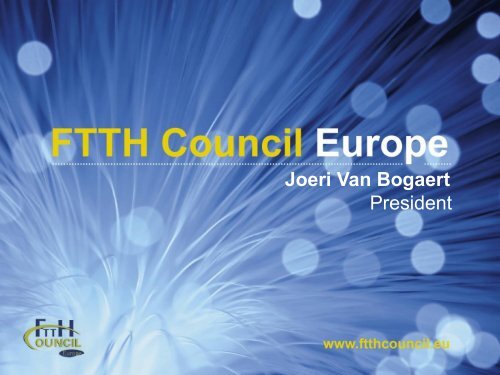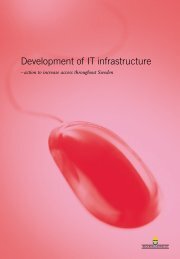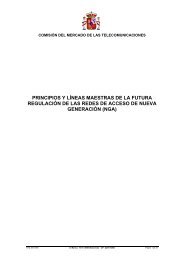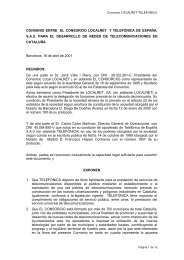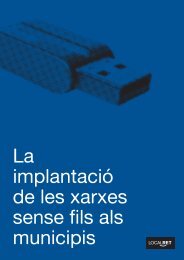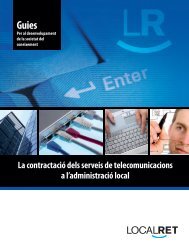FTTH - Localret
FTTH - Localret
FTTH - Localret
Create successful ePaper yourself
Turn your PDF publications into a flip-book with our unique Google optimized e-Paper software.
Joeri Van Bogaert<br />
President
AGENDA
<strong>FTTH</strong> Council Europe
<strong>FTTH</strong> Council Europe
<strong>FTTH</strong> Faces 2008<br />
Joeri Van Bogaert<br />
LEONI NBG<br />
Fiber-Optics<br />
<strong>FTTH</strong> Council President<br />
Wolfgang Fischer<br />
Cisco<br />
Member of the board<br />
Sophie Pautonnier<br />
Mitsubishi<br />
Treasurer &<br />
Member of the board<br />
Board Chairs Team<br />
Kathleen de Smedt<br />
Alcatel-Lucent<br />
Member of the board<br />
Karel Helsen<br />
Draka Comteq<br />
Member of the board<br />
Roberto Santini<br />
Kocsisi<br />
Emtelle<br />
Member of the board<br />
Christian Emborg<br />
DKT<br />
Member of the Board<br />
Christian Ollivry<br />
Motorola<br />
Member of the Board<br />
Galit Wellner<br />
ECI Tele<br />
Member of the Board<br />
Simon Aspinall<br />
Cisco<br />
Chair of Network &<br />
Service Revenue Committee<br />
Chris Holden<br />
Corning<br />
Chair of Deployement &<br />
Operations Committee<br />
Joannes De Wilde<br />
Chair of Sustainable<br />
Development Committee<br />
Olivier Danthine<br />
GNS<br />
Chair of Policy &<br />
Regulation Committee<br />
Floyd Wagner<br />
Motorola<br />
Chair of Market<br />
Intelligence Committee<br />
Albert Grooten<br />
Draka Comteq<br />
Chair of Economics<br />
adhoc Committee<br />
Hartwig Tauber<br />
Director General<br />
Marie-Alix Lebrun<br />
Secretariat<br />
Sally Van den bemden<br />
Communications Fellow
<strong>FTTH</strong> Council Europe Members<br />
3M Telecommunications - Acome - ADC KRONE - AFL Europe - Agilent Technologies -<br />
Aksh Optifibre - Alcatel-Lucent - Allied Telesyn - BAM Infratechniek - Bael Ingenieria -<br />
Bechtel - BKtel Communications - Broadlight - Cable Telecommunications Training<br />
Services - Catway Lan System - Channel - Cisco Systems - Citinet Espania –<br />
Comptoir des Signaux - Corning - Dantex Plastrør - Dätwyler Cables - DKT - Draka<br />
Comteq - DSM Desotech - Duraline - ECI Telecom - Egeplast - EMC Electronic Media<br />
Communication - Emtelle - Enablence Technologies Inc. - Ericsson - Exfo Europe -<br />
Fibox Oy - Fibre Fab - Fraunhofer Institut - Freescale Semiconductor - Gabo<br />
Systemtechnik - Genexis - Gerald Glaise - GM Plast – GNS - Hellermann Tyton - Hitachi<br />
Communication Technologies - Huber+Suhner - ICTL Optical Links - Ignis Photonyx -<br />
IMC Fachhochschule Krems - Intel - Iskratel - JDSU - Kabel-X - Kathrein-Werke -<br />
LEONI NBG Fiber Optics - Mitsubishi Electric - Motorola - Mulder-Hardenberg -<br />
NetAdmin Systems - Nexans - OFS - Optral - PacketFront - Plumettaz - Preformed Line<br />
Products - Prysmian - RDM - Senko - Nokia Siemens - Scheu Netzplanung - Silec Cable<br />
- Sterlite Optical Technologies - Telec International - Teleste - Tilgin – Triax - TVC UK<br />
Holding - Twentsche Kabelfabriek - Tyco Electronics - Uponor/Radius - Volex Europe -<br />
Volker Wessels Telecom - Wavin - World Wide Packets - ZTE Corporation
<strong>FTTH</strong> Worldwide
Global ranking<br />
• Joint project of the three <strong>FTTH</strong>-Councils worldwide<br />
• Based on market-research of the councils, using the<br />
<strong>FTTH</strong>-Council <strong>FTTH</strong>-Definitions Document<br />
• Ranking: Percentage of households in a<br />
country/economy that have a <strong>FTTH</strong>-connection<br />
(subscribers)<br />
• All countries with more than 1% <strong>FTTH</strong>-penetrations are<br />
included
FTTx Definitions<br />
Included<br />
• <strong>FTTH</strong>ome – Complete Fiber Path to Home<br />
– in-building cables: house copper or fiber or wireless<br />
• FTTBuilding – Fiber to Apartment / Office Building<br />
– in-building cables: building copper or fiber regarded as a transitional<br />
stage to <strong>FTTH</strong><br />
• Both defined in 2006 <strong>FTTH</strong> Council, <strong>FTTH</strong> Definitions Document<br />
– http://www.ftthcouncil.org/?t=83&search_key=ftth+definitions<br />
Not Included<br />
• FTTCurb / FTTNode – Fiber to Street Cabinet<br />
– distribution and drop cables using telco copper (DSL) or new copper<br />
– categorised as DSL technologies.
<strong>FTTH</strong> Worldwide June 2008<br />
~3.2M<br />
~1.3M ~24M<br />
...and <strong>FTTH</strong> continues to grow
Global <strong>FTTH</strong>/FTTB Ranking<br />
>> Economies with the Highest Penetration of Fiber-to-the-Home / Building+LAN<br />
Mid-Year 2008 Ranking<br />
Source: Fiber-to-the-Home Council – Jul 08
<strong>FTTH</strong> in Japan<br />
• <strong>FTTH</strong>-subscribers exceed 10 million households<br />
• Nearly 300,000 new subscribers per month<br />
• DSL migrates to <strong>FTTH</strong>: number of DSL-subscribers<br />
decrease since Q02/06<br />
• Nearly 60,000 subscribers per month switch from<br />
DSL to <strong>FTTH</strong><br />
>> Broadband-Subscribers in Japan<br />
Source: www.soumu.go.jp
<strong>FTTH</strong> in USA<br />
• <strong>FTTH</strong>-subscribers exceed 3 million households<br />
• More than 10 million households passed<br />
• <strong>FTTH</strong>-growth-rate more than 100%<br />
>> North America: <strong>FTTH</strong> Homes Connected<br />
Source: www.soumu.go.jp
<strong>FTTH</strong> in Europe
deployment<br />
Early adopters<br />
2000<br />
Communities &<br />
Utility comp.<br />
2002<br />
Major European<br />
cities<br />
2006<br />
2007-20xx<br />
>> <strong>FTTH</strong> WW development Europe<br />
Incumbent<br />
operators<br />
time
<strong>FTTH</strong> in Europe<br />
Status December 2007<br />
• Over 1 Mio. Subscribers,<br />
5 Mio. Homes passed<br />
• 80% of subscribers<br />
in just 4 countries<br />
• Majority of projects are<br />
driven by municipalities<br />
and utility-companies<br />
Source: <strong>FTTH</strong>-Council Europe/IDATE 2008
<strong>FTTH</strong> in Europe<br />
Source: <strong>FTTH</strong>-Council Europe/IDATE 2008
<strong>FTTH</strong> in Europe<br />
2008: Europe moves forward<br />
• France: major deployments in the big cities<br />
• Netherlands: continue to deploy fibre<br />
• Denmark: power-utility-companies deploy fibre<br />
• Switzerland: Zurich starts <strong>FTTH</strong>-project<br />
• Germany: municipalities and power-utility-companies start to<br />
deploy <strong>FTTH</strong><br />
• Slovenia: incumbent deploys <strong>FTTH</strong> in whole country –<br />
“newcomer” in global ranking<br />
• Europe: in the majority of the EU-countries <strong>FTTH</strong> is still not<br />
happening!
<strong>FTTH</strong> Market Forecast
European <strong>FTTH</strong> Forecast<br />
Source: <strong>FTTH</strong>-Council Europe/Heavy Reading, 2008<br />
20
Conected Households, 0s<br />
APAC <strong>FTTH</strong> Forecast<br />
1170<br />
1901<br />
3346<br />
Source: <strong>FTTH</strong>-Council Europe/Heavy Reading, January, 2008<br />
5538<br />
9234<br />
15056<br />
2007 2008 2009 2010 2011 2012<br />
21
<strong>FTTH</strong> Broadband Bandwidth Usage
Basic Questions<br />
• Is <strong>FTTH</strong>-bandwidth needed?<br />
• Is <strong>FTTH</strong>-bandwidth used?<br />
• Is <strong>FTTH</strong>-bandwidth demanded?<br />
Study to examine theses questions from a<br />
technological point of view
Hypothesis and Results<br />
Nielson’s law:<br />
“The end-user connections-speeds will grow by 50% per<br />
year”<br />
The law was first tested from the supply-side:<br />
• The growth rate of 50% per annum held true for most<br />
European countries<br />
Then the law was tested from the usage-perspective:<br />
• The growth rate of high speed bandwidth usage is<br />
growing at an annual rate of 20%
Broadband Usage - Ventura<br />
Poland is doing well but illustrates a simplification in Nielsen’s<br />
Law<br />
• Poland is a perfect example for Nielsen’s Law<br />
• Other countries have even faster (Sweden) or slightly slower<br />
increase (Spain)<br />
• Logarithmic extrapolation works neraly in all countries<br />
Source: Ventura<br />
*
Broadband Usage - Ventura<br />
Fibred homes already generate 3x the traffic per home of ADSL<br />
>> Inbound traffic Mbits/sec/Sub – 24hr average<br />
• While most of the world is on ADSL, fibre traffic is limited.<br />
• As fibre speed applications become more common, expect 50% pa traffic growth.<br />
Source: Ventura - Remark: ADSL average was devised from operators with predominantly ADSL, with limited / no fibre.
Summary<br />
• European broadband speeds are rising at 50%+<br />
per annum.<br />
• High end broadband usage per home is growing at<br />
20% per annum.<br />
• <strong>FTTH</strong> broadband homes drive 3x more traffic than<br />
ADSL in Europe.<br />
• End users use higher bandwidth as soon as it is<br />
provided!
<strong>FTTH</strong> and Regulation
Regulatory Framework<br />
• Regulation vs. Public policy<br />
• A stable and predictable regulatory and public policy<br />
environment is key to enabling <strong>FTTH</strong> investment<br />
• The current Regulatory Framework is being reviewed;<br />
to conclude in Summer 2008?<br />
• We are pleased to see that Next Generation Access is<br />
a major component of the Review<br />
• The Council has developed a strong pro-investment<br />
position
Regulatory Framework<br />
<strong>FTTH</strong> Council Europe calls on the Commission<br />
to provide a regulatory framework with:<br />
I. A coordinated and coherent industrial policy.<br />
– A clear incentive for the large-scale investment<br />
required for deploying end-to-end <strong>FTTH</strong> solutions at<br />
mass-market levels.<br />
– “Technology neutrality" rationale is already taking a bias
Regulatory Framework<br />
II. Clear and precise rules, in order to support a<br />
rapidly evolving sector:<br />
– Prioritization between the different rationales<br />
– Hierarchy of remedies<br />
– A well-defined ladder of investment for the operators<br />
(both incumbents and competitors) who are willing to<br />
invest in NGA.
Regulatory Framework<br />
I. Encourage investment in infrastructure at the lowest<br />
sustainable level starting from the passive infrastructure.<br />
– Prefer infrastructure-based competition over service-based<br />
competition<br />
– Duct sharing<br />
– Redefinition of the local loop; a new market for physical<br />
passive infrastructure<br />
– In “Policy driven” areas state aid and public intervention<br />
will be necessary...<br />
– ... while "market driven" areas should be left to competition<br />
rules.<br />
– In the “grey areas”, the regulatory intervention should be<br />
gradated starting from the lowest physical element
Geographical segmentation
<strong>FTTH</strong> and Bandwidth
The story of bandwith<br />
• Average Speed of Broadband-Customers (Verizon, US):<br />
2.5 Mbit/s DSL-Customers<br />
5.2 Mbit/s FIOS (<strong>FTTH</strong>) – Customers<br />
>> Is <strong>FTTH</strong> necessary for 5.2 Mbit/s?
The story of bandwith<br />
• Average Speed of a car:<br />
39.11 km/h in US (University of California)<br />
24.5 km/h in UK (Oxford University)<br />
>> Are modern cars necessary for 24.5 km/h?
The story of bandwith<br />
• Download of a 6.5 Gbyte DVD-film:<br />
10 Mbit/s DSL: 1.44 hours<br />
100 Mbit/s <strong>FTTH</strong>: 8.6 min
The story of bandwith<br />
• Download of a 25 Gbyte HD-film:<br />
10 Mbit/s DSL: 5.5 hours<br />
100 Mbit/s <strong>FTTH</strong>: 33 min
The story of bandwith
Symmetrical bandwith<br />
• Too much focus on downstream<br />
• Upstream is needed for<br />
a growing number of applications<br />
• <strong>FTTH</strong> offers symmetrical<br />
bandwidth/high upstream-rates<br />
Upload of 300 holiday-photos (700 Mbyte):<br />
• 1 Mbit/s Upstream: 92 minutes<br />
• 10 Mbit/s Upstream: 9 minutes<br />
• 100 Mbit/s Upstream: 56 seconds<br />
Videoconferencing<br />
Interactive Content<br />
Online-Gaming<br />
Web 2.0<br />
Blog<br />
Teleworking<br />
Multimedia-Upload
<strong>FTTH</strong> Market-Drivers
<strong>FTTH</strong> impacts our life<br />
eLeisure<br />
eBusiness<br />
Web 2.0<br />
eGovernment<br />
eHealth<br />
eHome<br />
eEducation<br />
Environmental<br />
Teleworking<br />
Societal
<strong>FTTH</strong> and leisure<br />
• Standard-Package:<br />
• Unlimited, symmetrical high-speed-internet<br />
• VoIP<br />
• IPTV with multiple (HD)-Channels<br />
• Video on Demand<br />
• Local content<br />
• Interactive TV<br />
• The connected home:<br />
more than just “Triple Play”
<strong>FTTH</strong> and leisure<br />
• The “Triple-Play-Family” on Friday evening - TODAY:<br />
Service Mbit/s<br />
HD-Stream for Living-Room-TV: 9,0<br />
HD-Stream recorded in parallel 9,0<br />
Standard-TV-Stream in daughters room 2,5<br />
VoD-Music-Clips streamed to PC of son 2,5<br />
Download of MP3-files to PC of son 2,0<br />
Mother having a video-chat with Grandma 1,3<br />
Total 26,3<br />
+20% puffer for permanent video 31,6<br />
source: IMC 2007<br />
• Short peaks for internet-surfing, download of software-updates etc. are not taken into<br />
account<br />
• Bandwidth has to be available stable and with sufficient QoS<br />
• Picture in Picture or other interactive features would increase bandwidth<br />
Source: IMC 2007
The future of IPTV<br />
Source: Keyser Söze<br />
• HDTV is just the<br />
start<br />
• Why re-encode<br />
2K and 4K digital<br />
movies?<br />
• Japan already<br />
works on<br />
UHD-Video<br />
• Which BBtechnology<br />
other than <strong>FTTH</strong><br />
will be able<br />
to stream<br />
150-200 Mbit/s?
<strong>FTTH</strong> enables Knowledge Economy
<strong>FTTH</strong> Communities & Web 2.0<br />
• User-Centric Content demands<br />
Symmetrical Bandwidth<br />
• Unlimited bandwidth gives<br />
unlimited possibilities to the<br />
communities<br />
• Give the bandwidth to the users<br />
and they will use it<br />
“Second Life”<br />
Virtual<br />
media
<strong>FTTH</strong> and Sustainable Development
Process SUDEFIB
Project Background<br />
Sustainable Development is defined as development that:<br />
“meets the needs of the present without compromising the ability of<br />
future generations to meet their own needs”.*<br />
The goal was to assess the sustainability aspects of European <strong>FTTH</strong><br />
deployments in urban, suburban, and rural scenarios using Life Cycle<br />
Analysis (LCA) methodology<br />
The <strong>FTTH</strong> Council Europe’s key objectives for this study were:<br />
– Evaluate and understand the environmental impacts from the<br />
implementation of <strong>FTTH</strong> technology<br />
– Qualify the resulting quality of life enhancements from the point<br />
of view of sustainable development<br />
– Educate stakeholders by providing a new approach for enabling<br />
the promotion and acceleration of <strong>FTTH</strong> solutions<br />
*United Nations. 1987."Report of the World Commission on Environment and Development."
Project Background<br />
Sustainability Business Services (SBS)<br />
of PwC/Ecobilan is a global leader in<br />
providing sustainable business<br />
solutions with:<br />
– Over 500 governance, social,<br />
environmental specialists,<br />
throughout 45 countries;<br />
– a network of over 700<br />
social/ethical compliance<br />
monitors (PwC staff)<br />
conducting supply chain audits<br />
in over 70 countries; and,<br />
– And a large number of<br />
specialists in human resources,<br />
value measurement and<br />
management, and climate<br />
change
Modeling and Life Cycle Tool<br />
The LCA practice, according to ISO 14040/44 consists of:<br />
•Defining a goal and scope for the project: which question is addressed?<br />
What will be the reference for calculations?<br />
•Defining the studied system along the life cycle of the product: braking it into<br />
units for which environment data will be gathered, modelling and processing<br />
the data using software, generating a output – Life Cycle Inventory (“LCI”)<br />
•Making an impact assessment (LCIA)<br />
•Analysing the inventory and impact<br />
assessment results:<br />
contribution analyses<br />
•Drawing interpretations of the results,<br />
through sensitivity analyses,<br />
scenario analyses
Modeling and Life Cycle Tool<br />
• This study is “a cradle to<br />
grave” screening LCA study: it<br />
covers the production steps,<br />
from the raw materials<br />
“in earth” (the cradle)<br />
to the <strong>FTTH</strong> network end<br />
of life (the grave).<br />
• Ecobilan has modelled the<br />
<strong>FTTH</strong> network impacts and<br />
associated services savings<br />
using a life-cycle approach with<br />
its proprietary Life Cycle<br />
Assessment (“LCA”) software<br />
tool TEAM.<br />
Cable and passive<br />
equipment production<br />
Transport<br />
Passive fiber network<br />
deployment<br />
Use: Network power<br />
consumption<br />
End of life<br />
Active equipment<br />
production
Modeling and Life Cycle Tool<br />
The study incorporates an analysis of key<br />
variables that influence the amount of resources<br />
consumed by <strong>FTTH</strong> deployments<br />
Parameters for Scenarios:<br />
•Area type<br />
(urban/suburban/rural)<br />
•Dwelling type<br />
(single home/MDU)<br />
•Installation type<br />
(digging/sewers/etc.)<br />
•Deployment type<br />
(P2P, PON, etc.)
Selected Services<br />
Teleworking, telemedicine and home assistance<br />
have been assessed.<br />
Three cases have been envisioned for<br />
telemedicine: teledialysis, telemedical meetings<br />
and medical imaging transfer.<br />
From the current trends (2010-2011 and beyond)<br />
in <strong>FTTH</strong> networks use, we have chosen the<br />
following ratios:<br />
•10% of the working population can telework 3<br />
days per week.<br />
•20% of the senior population (75 years old and<br />
over) can benefit from home assistance.
Main Outcomes<br />
>> Phases to climate change potential impacts<br />
4. Passive fiber network<br />
Deployment<br />
78 %<br />
3. Transport<br />
0%<br />
2. Active equipements<br />
production<br />
8%<br />
1. Cable and<br />
Passive equipment<br />
production<br />
7%<br />
5. Network Power<br />
consumption<br />
6. End of life<br />
1%<br />
6%
Main Outcomes<br />
• The environmental impact of the deployment of a typical <strong>FTTH</strong> network will be<br />
positive in less than 15 years considering only the three selected services<br />
• Beyond its environmental-friendly aspects, <strong>FTTH</strong> solutions offer serious additional<br />
social and economical benefits<br />
• Regarding the potential greenhouse gas impact, the deployment phase is<br />
predominant and represents approximately 80% of the total impact of <strong>FTTH</strong><br />
network<br />
• If we admit the fact that we are in the middle of a new industrial era, <strong>FTTH</strong><br />
solutions are a key sustainable utility driver in this context.<br />
• “<strong>FTTH</strong> networks enable society changes for a sustainable future”…<br />
Just imagine!
<strong>FTTH</strong> life Cycle Analysis USA
<strong>FTTH</strong> LCA in USA<br />
• <strong>FTTH</strong> Council North America did<br />
similar study<br />
• Differences to Europe<br />
• Only telecommuting was<br />
selected as service (no<br />
telemedicine)<br />
• Based on the current trends<br />
(2010-2011and beyond) in NA<br />
<strong>FTTH</strong> network usage,<br />
assumption that 10% of the<br />
working population can<br />
telecommute 3 days per week<br />
• <strong>FTTH</strong>-networks are partly<br />
deployed areal on poles
Results in USA<br />
• As a main quantitative finding, the environmental impact of a typical<br />
deployed <strong>FTTH</strong> network will be positive within an average of less<br />
than 6 years, considering only the savings from telecommuting.<br />
• Existing and/or developing applications will only enhance this result.<br />
• Beyond their environmental-friendly aspects, <strong>FTTH</strong> solutions can<br />
offer considerable additional social and economical benefits.<br />
• With the assumption of a future low-carbon economy and increased<br />
environmental regulation, <strong>FTTH</strong> solutions are a key sustainable<br />
utility driver.<br />
• <strong>FTTH</strong> represents an environmentally positive investment for<br />
telecommunication service providers
<strong>FTTH</strong> European Success Stories
Case – Free (France)<br />
• What<br />
– Replacement of ADSL2+ by <strong>FTTH</strong><br />
• Where & how<br />
– Planned in Paris and everywhere in France where Free/ADSL2+ has<br />
a high market-share<br />
– Free-customers will be upgraded for free, no change in monthly fees<br />
– Free also announced to<br />
open network to other<br />
operators<br />
• <strong>FTTH</strong><br />
– Investment planned:<br />
1 billion Euros until 2012
Case – Malarenergi/Vasteras<br />
• What<br />
– One of the first Open-Networks in Sweden<br />
– Combined with a portal of the municipality which provides networkingopportunities,<br />
E-Government and user-support<br />
• Where & how<br />
– City of Vasteras, Sweden<br />
– Built by the local utility company which only operates network and<br />
provides no services<br />
– More than 100 services form<br />
more than 20 serviceproviders<br />
are available<br />
• <strong>FTTH</strong><br />
– 35.000 households &<br />
2.000 businesses connected
Case – Reykjavik Energy<br />
• What<br />
– Open Access Network in Iceland, owned by municipalities<br />
– Long-term project with ROI of 14 years – focus on macroeconomic<br />
benefits<br />
• Where & how<br />
– Deployment in and around Reykjavik/Iceland<br />
– Low connections-fee of EUR 25,-- including TV and 100 MBit<br />
– Iceland is in the Global<br />
Ranking<br />
• <strong>FTTH</strong><br />
– Plan: 5.300 subscribers/<br />
26.000 homes passed in 2008<br />
– Investment of $100 millions
Case – City of Graz<br />
• What<br />
– <strong>FTTH</strong>-Network built by Grazer Stadtwerke (utility company)<br />
– Services provided by one selected service-provider<br />
– Full triple-play-offering<br />
• Where & how<br />
– Located in Graz, Austria<br />
– Primary focus on greenfield but also existing households<br />
– 100 Mbit flatrate for each<br />
customer<br />
• <strong>FTTH</strong><br />
– 2008: 15.000 homes passed, 1.000 subscribers
Case – Citynet Amsterdam<br />
• What<br />
– <strong>FTTH</strong>-network initiated by City of Amsterdam<br />
– Built by private companies as an Open Network<br />
• Where & how<br />
– Deployed in Amsterdam, The Netherlands<br />
– Strict Open Access network design, passive network / network-operator /<br />
service provider has to be different companies<br />
– Amsterdam-project was<br />
accepted by European<br />
Commission<br />
• <strong>FTTH</strong><br />
– First phase with 40.000<br />
homes passed in progress<br />
– Plan: 420.000 households<br />
and businesses by 2013
Case – Reggefiber<br />
• What<br />
– Private investor built several <strong>FTTH</strong>-networks in Dutch Cities<br />
– Strong involvement of local people<br />
– Also involved in Citynet Amsterdam<br />
• Where & how<br />
– <strong>FTTH</strong> in several Cities in The Netherlands<br />
– Dutch Incumbent, KPN bought 41% of<br />
Reggefiber in 2008, option to buy majority<br />
– High quality triple-playofferings<br />
• <strong>FTTH</strong><br />
– More than 100.000 customers connected
<strong>FTTH</strong> Closing
<strong>FTTH</strong> conclusion
Next conference: Denmark ‘09<br />
More at our next conference:<br />
Denmark >> Copenhagen >> Bella center<br />
11-12 February ’09
<strong>FTTH</strong> COUNCIL EUROPE<br />
Thank you for your attention!


